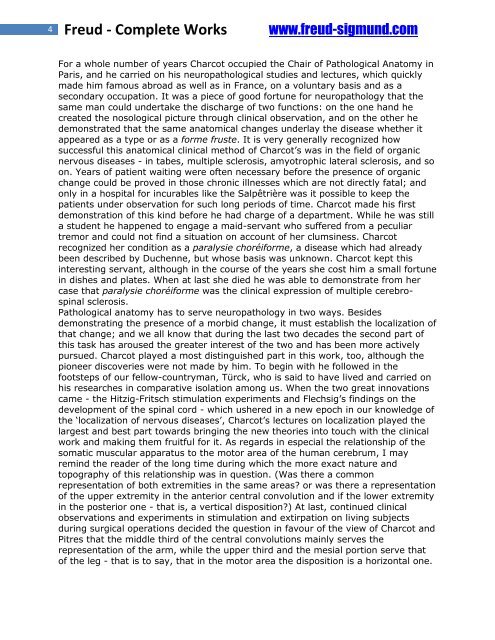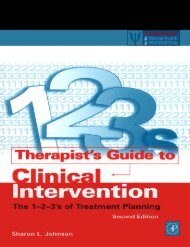Charcot - Sigmund Freud
Charcot - Sigmund Freud
Charcot - Sigmund Freud
You also want an ePaper? Increase the reach of your titles
YUMPU automatically turns print PDFs into web optimized ePapers that Google loves.
4 <strong>Freud</strong> - Complete Works www.freud-sigmund.com<br />
For a whole number of years <strong>Charcot</strong> occupied the Chair of Pathological Anatomy in<br />
Paris, and he carried on his neuropathological studies and lectures, which quickly<br />
made him famous abroad as well as in France, on a voluntary basis and as a<br />
secondary occupation. It was a piece of good fortune for neuropathology that the<br />
same man could undertake the discharge of two functions: on the one hand he<br />
created the nosological picture through clinical observation, and on the other he<br />
demonstrated that the same anatomical changes underlay the disease whether it<br />
appeared as a type or as a forme fruste. It is very generally recognized how<br />
successful this anatomical clinical method of <strong>Charcot</strong>’s was in the field of organic<br />
nervous diseases - in tabes, multiple sclerosis, amyotrophic lateral sclerosis, and so<br />
on. Years of patient waiting were often necessary before the presence of organic<br />
change could be proved in those chronic illnesses which are not directly fatal; and<br />
only in a hospital for incurables like the Salpêtrière was it possible to keep the<br />
patients under observation for such long periods of time. <strong>Charcot</strong> made his first<br />
demonstration of this kind before he had charge of a department. While he was still<br />
a student he happened to engage a maid-servant who suffered from a peculiar<br />
tremor and could not find a situation on account of her clumsiness. <strong>Charcot</strong><br />
recognized her condition as a paralysie choréiforme, a disease which had already<br />
been described by Duchenne, but whose basis was unknown. <strong>Charcot</strong> kept this<br />
interesting servant, although in the course of the years she cost him a small fortune<br />
in dishes and plates. When at last she died he was able to demonstrate from her<br />
case that paralysie choréiforme was the clinical expression of multiple cerebrospinal<br />
sclerosis.<br />
Pathological anatomy has to serve neuropathology in two ways. Besides<br />
demonstrating the presence of a morbid change, it must establish the localization of<br />
that change; and we all know that during the last two decades the second part of<br />
this task has aroused the greater interest of the two and has been more actively<br />
pursued. <strong>Charcot</strong> played a most distinguished part in this work, too, although the<br />
pioneer discoveries were not made by him. To begin with he followed in the<br />
footsteps of our fellow-countryman, Türck, who is said to have lived and carried on<br />
his researches in comparative isolation among us. When the two great innovations<br />
came - the Hitzig-Fritsch stimulation experiments and Flechsig’s findings on the<br />
development of the spinal cord - which ushered in a new epoch in our knowledge of<br />
the ‘localization of nervous diseases’, <strong>Charcot</strong>’s lectures on localization played the<br />
largest and best part towards bringing the new theories into touch with the clinical<br />
work and making them fruitful for it. As regards in especial the relationship of the<br />
somatic muscular apparatus to the motor area of the human cerebrum, I may<br />
remind the reader of the long time during which the more exact nature and<br />
topography of this relationship was in question. (Was there a common<br />
representation of both extremities in the same areas? or was there a representation<br />
of the upper extremity in the anterior central convolution and if the lower extremity<br />
in the posterior one - that is, a vertical disposition?) At last, continued clinical<br />
observations and experiments in stimulation and extirpation on living subjects<br />
during surgical operations decided the question in favour of the view of <strong>Charcot</strong> and<br />
Pitres that the middle third of the central convolutions mainly serves the<br />
representation of the arm, while the upper third and the mesial portion serve that<br />
of the leg - that is to say, that in the motor area the disposition is a horizontal one.



